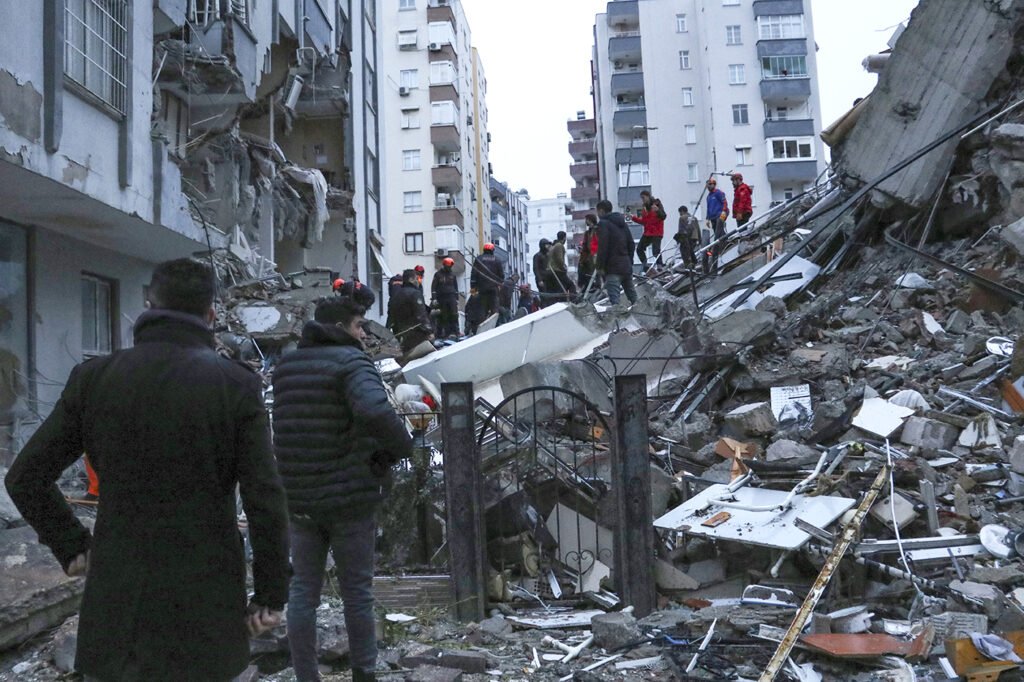Horrific. Tsunami after the earthquake hit the coast of Turkey. Recently released update so far 2,379 people have been killed and 13,293 injured. #TurkeyEarthquake pic.twitter.com/tMgohXAV2l
— Omid Djalili (@omid9) February 7, 2023
ADANA, Turkey (AP) — After a 7.8 magnitude earthquake killed more than 4,000 people and wrecked thousands of structures across a vast region, rescuers in Turkey and war-torn Syria combed through the icy night into Tuesday, trying to retrieve more lives from the rubble.
Authorities anticipated that as rescuers searched through the tangles of metal and concrete scattered across the region plagued by Syria’s 12-year civil war and refugee crisis, the death toll from Monday’s early-morning earthquake and its aftershocks would continue to rise.
As first responders struggled in the rain and snow, survivors shouted out for assistance from among the mounds of rubble. The area was shaken by more earthquakes, including one that was almost as strong as the first one. As anxious relatives awaited word of loved ones, workers gently removed concrete slabs and reached for bodies.
“My grandson is one and a half. Please provide a hand to them. … They were on the 12th floor,” Imran Bahur sobbed Monday in front of her demolished apartment complex in the Turkish city of Adana.
In Turkey and Syria, tens of thousands of people who were made homeless had to spend the night outside in the cold. People sought sanctuary in malls, stadiums, mosques, and community centers in the Turkish city of Gaziantep, the province capital located about 33 kilometers (20 miles) from the epicenter. Recep Tayyip Erdogan, the president of Turkey, proclaimed seven days of national mourning.
U.S. President Joe Biden contacted Erdogan to offer support to the NATO ally and to convey his condolences. The White House announced that it would send search and rescue personnel to assist Turkey.
Residents of Damascus and Beirut rushed into the streets in response to the earthquake, which was felt as far away as Cairo and was centered in the province of Kahramanmaras in southeast Turkey.
It added to the region’s already extreme hardship over the previous ten years. On the Syrian side, the region is split between territory under government control and the final opposition-held outpost, which is encircled by government forces with Russian support. Millions of civil war refugees currently reside in Turkey.
Hundreds of families are still buried under the wreckage in the rebel-held area, according to a statement from the White Helmets, an opposition emergency response group. Approximately 4 million people who were displaced by the war from other regions of the country are crammed into the area. Many people reside in structures that have already been damaged by military bombardments.
Rescue workers reported that injured patients swiftly filled up overcrowded medical facilities. According to the SAMS medical group, some facilities, including a maternity facility, had to be evacuated.
According to Orhan Tatar, a representative of Turkey’s emergency management organization, more than 7,800 persons were saved across 10 provinces.
Major fault lines run through the area, which frequently experiences earthquakes. Similarly strong earthquakes that struck northwest Turkey in 1999 claimed over 18,000 lives.

The depth of Monday’s earthquake, as determined by the U.S. Geological Survey, was 18 kilometers (11 miles). A few hours later, a 7.5 magnitude earthquake struck more than 100 kilometers (60 miles) away, probably as a result of the previous one.
According to video of the incident, the second shock caused a multistory apartment building in the Turkish city of Sanliurfa to tumble onto the street in a cloud of dust as onlookers shouted.
In a large area that stretched from the Syrian cities of Aleppo and Hama to Diyarbakir, Turkey, more than 330 kilometers (200 miles) to the northeast, thousands of structures were believed to have collapsed.
According to authorities, more than 5,600 buildings have been damaged in Turkey alone. In the city of Iskenderun, hospitals were damaged, and one even collapsed.
According to Dr. Steven Godby, a specialist in natural hazards at Nottingham Trent University, the time that rescuers have to free trapped people could be shortened by bitterly cold weather. Rescue operations would be made more difficult by having to operate in conflict-ridden areas, he claimed.
Numerous nations, including the European Union and NATO, as well as search and rescue teams, medical supplies, and financial contributions all offered their assistance. The overwhelming majority were for Turkey, with promises of assistance to the Syrian government from Russia and even Israel, but it was unclear if any would get to the devastated rebel-held area in the northwest.
The Syrian Civil Defense, an opposition group, called the situation in the enclave “disastrous.”
The Idlib province and the opposition-held region have been subject to ongoing government and Russian bombardment for years. Everything from food to medical supplies comes from Turkey, and the region is dependent on this humanitarian flow.
U.N. According to spokesman Stephane Dujarric, 224 structures in northwest Syria were destroyed and at least 325 others, including assistance warehouses, were damaged. The U.N. had been providing cross-border supplies that helped 2.7 million people each month, which might now be interrupted.
Osama Abdel Hamid said at an Idlib hospital that the majority of his neighbors perished when the four-story building they shared collapsed. A wooden door that had fallen on them as they fled, protecting them from flying debris, crashed on him, his wife, and their three kids.
He claimed, “God gave me a fresh lease on life.”
The bodies of numerous deceased children, wrapped in blankets, were sent to a hospital in the little town of Azmarin, which is controlled by Syrian rebels and is located in the highlands close to the Turkish border.
Two kids were found alive amid the rubble of the Turkish city of Kahramanmaras, and one of them was lying on a stretcher on the snowy ground. According to CNN Turk, a rescue dog in Gaziantep found a woman and hauled her out alive.
About 20 individuals in Adana used power saws to cut a hole in the concrete mountain of a collapsed building so that any survivors might climb out or be rescued. Some of the workers were wearing emergency rescue jackets.
In Adana, a survivor was heard saying, “I don’t have the strength anymore,” as rescuers sought to get to him from beneath the wreckage of another building, according to local resident Muhammet Fatih Yavuz.

Thousands of rescuers and bystanders in Diyarbakir formed lines over a sizable pile of debris, passing down household items and broken pieces of concrete as they looked for trapped survivors.
Turkish authorities report that approximately 16,000 people have been hurt and at least 2,921 people have died in ten Turkish provinces. According to the Health Ministry, there have been 656 fatalities and 1,400 injuries in Syria’s government-controlled territories. At least 450 people died and hundreds were injured in the northwest of the country, which is controlled by rebels, according to parties operating there.
Several of Huseyin Yayman’s family members, a lawmaker from Turkey’s Hatay province, were reportedly trapped beneath their collapsed homes.
He said over the phone to HaberTurk television, “There are so many more people who are also trapped.” “So many structures have sustained damage. Streets are filled with people. Winter is here, it’s pouring.




